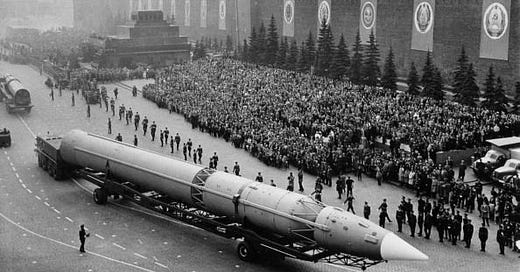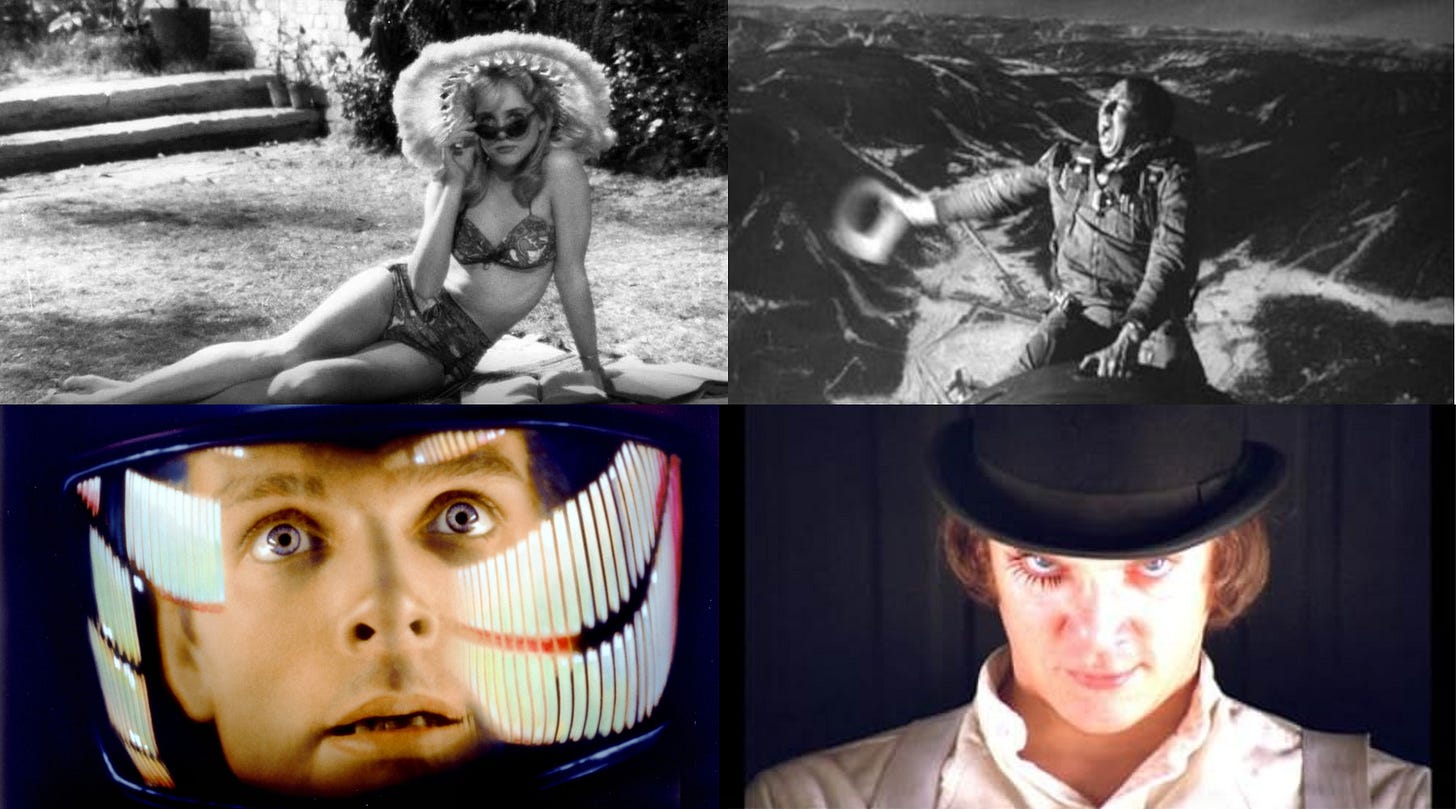Nihilism (or, the Religion of Groundlessness)
Chapter II, Part VI - The Myth of the 20th Century
In his essay ‘No Apocalypse, Not Now,’ Jacques Derrida writes that his idea of ‘deconstruction belongs to the nuclear age.’1 Haunted by the thought of groundlessness and annihilation, we saw that the very existence, possibility and significance of our culture and its archives of meaning could be destroyed—totally and without remainder. The bomb, in a way, was a force of différance.
After the end of WWII, all our present moments became contaminated by absence—by the memory of Hiroshima, by the anticipation of death—while any meaning became burdened by the thought of meaningless collapse. The threat of nuclear annihilation, our shared apocalyptic fiction bolstered by moments like the Cuban Missile Crisis, showed too that everything we thought to be necessary or enduring was prone to destruction; it showed how our societies, our culture, were not secure or necessary, but contingent and vulnerable. The bomb showed that there was no transcendental idea, signifier or moral that governed us, and that the world’s laws were not based on righteousness or virtue but were founded on force, on the capacity to bring death to the world. It showed how our highest values and beliefs—in science and enlightenment, in civilisation and culture, in freedom and rationality—were contaminated by their opposites: that they became triumphant only by repressing the irrationality and madness that fuelled them; culture progress became coextensive with the regression to violence, savagery, barbarism.2 The bomb demanded that we doubt our belief in human progress, for it was progress that led us to the brink of the most senseless death imaginable—extinction by mass murder-suicide. After the blasts in Japan, the ground opened beneath our feet, and we felt ourselves falling into a future where, eventually, we might vanish without a trace—a fear or a hope that marked every second and every day.
American writer Don DeLillo once said that ‘with the onset of the bomb the communal spirit becomes associated with danger and loss rather than with celebration.’3 He was right. After Hiroshima, our most ideals deconstructed themselves. When our ‘highest values hitherto devalue themselves,’ Nietzsche said, culture enters a period of active nihilism, and nihilism is precisely what the bomb brought. The bomb, and those craters in New Mexico and Nevada, those images of Hiroshima, gave us the thought of groundlessness, both physical and spiritual, and a world where anxiety, manic excitation and collapse reigned over both hope and despair.
The nihilism inaugurated by the bomb reshaped the world. All it unleashed—the forces of sexual liberation, the culture of immediate gratification and consumption, the narcissistic individualism, the collapse of value structures, the spiritual yearning, the pervasive sense of irony and ambivalence towards sources of authority, the disintegration of our sense of safety and the collective anticipation of death—all this ushered in a new cultural epoch. George Steiner called it ‘postculture.’ But today it is best known as postmodernism. And its new sensibilities could be seen in works of art across the culture. Thomas Pynchon, that man who felt ‘somber glee’ at the idea of annihilation, gave us 1971’s Gravity’s Rainbow—his novel of sex, death and missiles. Later, Don DeLillo delivered his magnum opus, 1997’s Underworld, his startling meditation on the American century, the century of the bomb. In film, Jean-Luc Godard’s Breathless expressed the logic of postculture by collapsing time into fragments of intensity, sexuality, and absurd violence. And Stanley Kubrick, perhaps, exemplified the era’s sensibilities in his films, Lolita, Dr. Strangelove, 2001: A Space Odyssey and A Clockwork Orange. Exploring themes like taboo sexuality, the libidinal underpinnings of masculine violence, and the terrifying yet orgastic possibilities of nuclear conflict, the spiritual questing of the space race, and the nihilistic, sexualised violence of empty, urban life, Kubrick showed how our highest values were condemning themselves. He captured our culture’s response to the groundlessness—the nihilism, the deconstruction, the death anxiety—that followed the Trinity Test.
The bombing of Hiroshima helped to end the war against fascism in 1945. But the nuclear blasts on August 6th that year ultimately became a major blow to the sense of self-integrity of people and societies everywhere. From the groundlessness burned liked a black hole into the world’s dreams, a new shared imaginary emerged—a nihilistic myth for the 20th century that gave life and death a new meaning and purpose.
As we shall see, the earth-shaking vibrations of the bomb echoed through the following decades, leading us where we find ourselves today—the world of ante-fascism. But it also opened the way for a whole new kind of artist to emerge—the creators of ‘postculture.’ The David Bowies of our world.
References
Derrida, J. (1984) No Apocalypse, Not Now (Full Speed Ahead, Seven Missiles, Seven Missives. Diacritics, 14(2). pp. 20-31.
Footnotes
See ‘No Apocalypse, Not Now (Full Speed Ahead, Seven Missiles, Seven Missives),’ p.27.
As Steiner once said on the link between barbarism and culture: ‘Gieseking was playing the complete Debussy piano music on the nights when one could hear the screams of the people in the sealed railway cars at the station in Munich on the way to Dachau, just outside Munich. They could be heard all the way to the concert hall. That is on record. There's not the slightest witness that he didn't play magnificently or that his audience wasn't wholly responsive and profoundly moved.’ See https://www.theparisreview.org/interviews/1506/the-art-of-criticism-no-2-george-steiner







